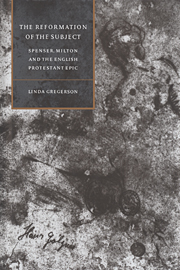Book contents
- Frontmatter
- Contents
- Acknowledgments
- Introduction
- 1 Emerging likeness: Spenser's mirror sequence of love
- 2 The closed image
- 3 Narcissus interrupted: specularity and the subject of the Tudor state
- 4 The mirror of romance
- 5 Fault lines: Milton's mirror of desire
- 6 Words made visible: the embodied rhetoric of Satan, Sin, and Death
- 7 Divine similitude: language in exile
- List of works cited
- Index
Introduction
Published online by Cambridge University Press: 08 October 2009
- Frontmatter
- Contents
- Acknowledgments
- Introduction
- 1 Emerging likeness: Spenser's mirror sequence of love
- 2 The closed image
- 3 Narcissus interrupted: specularity and the subject of the Tudor state
- 4 The mirror of romance
- 5 Fault lines: Milton's mirror of desire
- 6 Words made visible: the embodied rhetoric of Satan, Sin, and Death
- 7 Divine similitude: language in exile
- List of works cited
- Index
Summary
In an essay on pictorial representation and the religious prohibitions that have recurrently constrained it, E. H. Gombrich offers two examples, frankly undocumented, of the regulatory history of image-making: in the Eastern church, he reports, two-dimensional images were traditionally regarded as permissible, but three-dimensional images were regarded as unacceptably dangerous on account of their deceptive realism or mimetic plausibility. This left unresolved the murky territory of sculptural reliefs, so the Eastern fathers devised a test: an image was to be forbidden if the beholder could successfully grab it by the nose. And further, Gombrich reports, there are “certain Jewish households” in Eastern Europe where even statuary is permitted, as long as the statue is flawed or incomplete, as when, for instance, a finger is missing. In its simplest terms, the following study of The Faerie Queene and Paradise Lost is an attempt to locate and describe the missing finger, the nose that prompts, then eludes, the grasp.
The iconoclastic controversy in early modern England picked up where the Byzantine iconoclastic controversy of the eighth and ninth centuries had left off, both sides grounding their doctrines of image-making and idolatry in an authoritative canon that included the dialogues of Plato, the Pauline epistles, and the writings of Augustine. Roughly, the difference between signs and idols was thought to reside in a single, pivotal distinction: the one maintained a transitive or referential status and pointed beyond itself, ultimately to the transcendent.
- Type
- Chapter
- Information
- The Reformation of the SubjectSpenser, Milton, and the English Protestant Epic, pp. 1 - 8Publisher: Cambridge University PressPrint publication year: 1995



